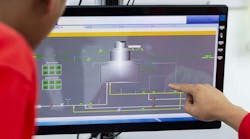Retimers: The Key to Reliability and Performance in Process Apps?
What you’ll learn:
- How Does a Retimer Work?
- What's New and Improved in Retimer Tech?
- Selecting the Right Retimer
- How Does the Retimer Handle Lanes?
Retimers are already built into a lot of technology like PCI Express (PCIe) and USB. However, to ensure that all of the components stay in sync and function at their best, they may need to be added in when implementing a large or complex process system.
"Retimer process control" is the application of a retimer chip to ensure the signal quality of data transmission within a network. This may not be necessary in small systems, but when cable runs get longer (an exact cutoff is hard to define) or when other issues are present that could impact signal quality, retimer tech comes to the rescue and can ensure proper functioning even over long distances.
This may sound a lot like a repeater, but a retimer isn’t a repeater. When signal degradation is a possibility, a repeater may simply worsen the problem. In contrast, a retimer is essentially regenerating a signal. Ideally, it exhibits protocol awareness and reclocks the signal to ensure that the signal at the start of the cable run is identical to what eventually emerges, regardless of the distance traveled or the factors potentially degrading the signal.
These capabilities are valuable in Internet of Things (IoT) as well as in general industrial automation situations that need high-speed data transmission. Employing retimers allows for larger and more dispersed operations. Even with much longer cable lengths, signal quality can be maintained. Similarly, existing infrastructure can usually provide greater bandwidth because signal quality is able to be maintained at higher data rates. And, of course, retimers can reduce or eliminate errors and jitter.
Retimers are also useful in other situations with dispersed equipment that’s run via a network, such as smart cities and hospital networks, which have similar requirements.
How Does a Retimer Work?
There are several elements in a retimer, including, in general, a clock data recovery (CDR) function, a transmit driver, and an equalizer.
>>Download the PDF of this article
The CDR has the vital job of detecting and replicating the clock signal in the data stream. It then generates a new clock signal and retimes the data transmission preparatory to transmission. A transmit driver then generates a strong, clean signal to ensure as much as possible that the signal reaches its destination intact. And, no doubt, an equalizer circuit is included in the retimer to ensure that signal shape and amplitude matches the original signal.
All of this computing and signal regeneration can lead to significant power demands, so power considerations need to be part of overall system design considerations.
What’s New or Improved in Retimer Tech?
As retimers evolved in recent years, improvements have appeared in basic capabilities and new features were also brought to market. And, generally, products are shrinking in form factor.
The newer crop of retimers have features like adaptive signal processing, lower power requirements, and improved integration, which has made it possible for retimers to handle more tasks and operate across more complicated networks.
With greater on-board intelligence, retimers are increasingly able adjust to meet signal needs in real-time. Circuitry is also becoming more efficient, helping to offset power requirements.
Selecting the Right Retimer
Many factors need to be weighed when choosing a retimer. Try to determine some basic things like the distances the signal must travel, factors that could contribute to degradation such as EMI, power availability, and the likely power consumption of a device. What data rate will you need to support, and is this consistent? What protocols must be employed? What’s the budget or what are cost constraints?
Particular attention should be given to jitter, which often originates from network congestion, inconsistent network conditions, variations in device processing power, and limitations in wireless signal strength. These things can lead to irregular data packet arrival times. Some retimers possess particularly strong capabilities for cleaning up jitter.
While retimers can be the cure, minimizing the sources of jitter also makes sense (see figure).
What data rate is necessary? The data rate supported by a retimer should be at least equal to the maximum rate in use now or likely to be implemented within the lifespan of the installation.
Find out what protocols are in use now (usually, but not always, easy to determine) and solicit views on what protocols might be needed in the future.
How Does the Retimer Handle Lanes?
There’s one more topic to examine in terms of retimers: lanes. In signal processing, a "lane" refers to a distinct, independent channel within a larger data stream, essentially a separate pathway for transmitting or processing information. It’s often used in high-speed data communication where multiple lanes are combined to achieve higher bandwidth by sending data simultaneously across different paths. Essentially, a lane is a logical grouping of signals within a single connection, allowing for parallel data transfer.
Lanes enable parallel data transfer by dividing the data into smaller streams, each processed independently within its lane. Lanes are commonly found in high-speed data interfaces like PCIe, where multiple lanes are combined to achieve high data throughput.
Retimers handle lanes by independently processing and correcting signal-integrity issues on each individual lane within a data link, actively compensating for lane-to-lane skew and ensuring all lanes arrive at the receiver with minimal distortion. Thus, each lane is effectively “retimed” to maintain signal quality across the entire data path.
With all of these considerations in mind, retimers can be a foundational element in building or enhancing process control and automation capabilities. They’re also likely to be a good investment in making an installation more adaptable and expandable.
References
Use a ReDriver™ or ReTimer for Longer and Thinner USB, USB Type-C, and DP Cables
>>Download the PDF of this article
About the Author



